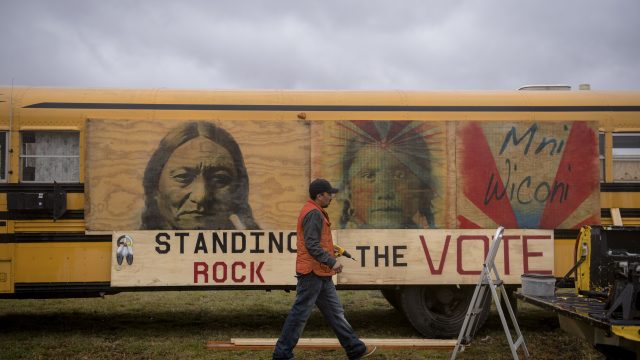Despite Claims of Voter Suppression, North Dakota’s Native Americans Got Out the Vote in a Big Away

Jesse McCloud puts up signs for voting on buses that will be used to bring voters to the polls, in the Standing Rock Sioux Tribe land in Fort Yates, N.D., Nov. 5, 2018. (Hilary Swift/The New York Times)
In what I consider to have been a partisan, cynical ploy to drive turnout, Democrats and left wing activist groups spent the last several weeks of the election cycle here in North Dakota claiming that our state’s voter ID laws were calculated to suppress Native American votes.
The problem? There’s no evidence this happened.
I looked up the preliminary 2018 voter turnout numbers (with all precincts reporting) for Sioux and Rolette Counties, where the Standing Rock and Turtle Mountain Reservations are located. I looked up those same numbers going back to 2012.
It turns out 2018 turnout wasn’t down, as you’d expect to be the case if votes were suppressed. It was actually up significantly over 2014, which was the last midterm election. In fact, turnout in those counties this year was up even a bit over the previous two presidential election cycles:
I should note that I did not include numbers here for the Forth Berthold Reservation, which is home to the Three Affiliated Tribes, or the Spirit Lake Sioux tribe.
Standing Rock and Turtle Mountain are both located in a single county, whereas the MHA Nation’s lands are in parts of a half dozen counties and Spirit Lake is in parts of five. I don’t have the resources at the moment to isolate the tribal vote from the overall turnout for those counties.
But I suspect the MHA and Spirit Lake numbers mirror what we saw at Standing Rock and Turtle Mountain.
And what we saw is hardly voter suppression, but rather very strong turnout.
Critics of the state’s voter ID laws can argue that the turnout was driven despite the alleged suppression because activists descended on the tribal communities and made sure people could vote. That’s no doubt a factor, but doesn’t it suggest that the solution to the state’s ID laws was just making the effort to comply? Rather than obnoxious political accusations and costly lawsuits which, while lucrative for the left wing lawyers who file them, seem to accomplish very little for the tribes?
I suspect that if the tribal communities had started last year to issue ID’s complying with North Dakota’s laws, there wouldn’t have been any need for this kerfuffle which took place in the closing days of the election.
Again, I don’t think this was ever really about the voter ID law. I think this was about getting out the vote for Heitkamp. The thing is, there just aren’t that many votes to be had in Indian Country.
In Sioux County there were just 2,752 eligible voters this election cycle. In Rolette County there were 9,643.
I’m glad voting was strong in Indian Country. There has long been a disconnect – culturally, economically, etc. – between our tribal communities and the rest of the state. North Dakota saw strong turnout for last night’s election overall. Seeing that trend extend to the reservation looks something like unity to this observer.
But it’s hard for me to countenance claims of voter suppression when, with some encouragement (and some unfortunately delinquent work on ID’s by the tribal governments) it seems like pretty much everyone who wanted to vote got to vote.





